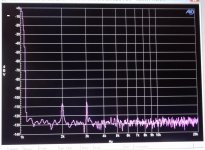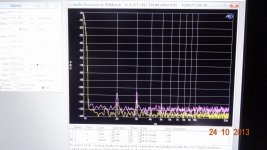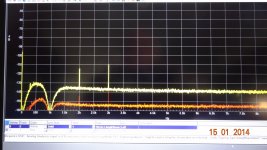I also used the two box approach with power supply chassis external from the amp. I also used two transformers and rect/filter... one for each regulator supply (+ and -). I know. Over-kill.... but there as the space and time and... well, you know how it goes... 
The regulators are inside the amp chassis close to the amp circuitry.
-RM
The regulators are inside the amp chassis close to the amp circuitry.
-RM
Last edited:
Well the Linear Audio (#6) design article by Borbeley came out... the topology is used but no mention of my earlier work for same app. Oh well. Just a straight forward redesign about noise, distortion etc. using fets.
Missed the main point of why i had developed it.... to reduce the distortion coming from the cartridge itself. So we still dont know any more about that aspect.
Thx-RNmarsh
Missed the main point of why i had developed it.... to reduce the distortion coming from the cartridge itself. So we still dont know any more about that aspect.
Thx-RNmarsh
Last edited:
The current input phono article? Erno wrote he thought the idea was proposed by Dr Tominari of Dynavector. Was he wrong about this?
Well the Linear Audio (#6) design article by Borbeley came out... the topology is used but no mention of my earlier work for same app. Oh well. Just a straight forward redesign about noise, distortion etc. using fets.
Missed the main point of why i had developed it.... to reduce the distortion coming from the cartridge itself. So we still dont know any more about that aspect.
Thx-RNmarsh
Could you point us in the right direction for your earlier work - a link perhaps.
Thx!
/S.
Thx!
/S.
Well the Linear Audio (#6) design article by Borbeley came out... the topology is used but no mention of my earlier work for same app. Oh well. Just a straight forward redesign about noise, distortion etc. using fets.
Missed the main point of why i had developed it.... to reduce the distortion coming from the cartridge itself. So we still dont know any more about that aspect.
Thx-RNmarsh
Its a strange reference to use the year 2006 marketing web site from Dynavector phono cartrdige mfr. They appear to have learned this or understood it at some point in time. There is no circuit topology or design given -- and no patent number given, either. No way to say they thought of this circuit arrangement first.
So, I do not believe they (DynaVector) invented any circuit to do this but someone did something along these lines for them.
What is also strange (to me) is that Borbely and I used the same magazine -The Audio Amatuer- to publish our DIY articles. The circuit is shown here and started to be discussed in another forum -- see "Mr Marsh's neat MC preamp ..." under the section -- Analogue Source.
There is/was a lot of behind the scenes work and people going on in the SF Bay area (Calif) at that time.... this would involve J.Curl and Erno and Peter Moncreieff and others (cartridge mfr's) and would turn this issue back into the soap opera it became. I know the corporate lawyers took a look at my submitted design and said it was patentable. However, they would release me to do what ever i wanted with the design as it had no value to the government and so they wouldnt spend money on it. So, a couple years later, I published it in TAA.
It was Peter M. who was doing the work of loading cart and listeneing and toalked to me about his results. Which got me thinking about how to accomplishe the same thing without the noise and gain degradation from very low Terminating R.
I dont need the grandizment or money... i just published it. Just a litle acknowledgement and discussion about the cartridge loading and how it could affect the distortion coming off the cartrdge. That is the real key as to why it and Borbelies circuit will sound better than traditional MC prepreamps. Not some magic about jFET are better or better parts or lower s/n or THd or what ever one might assume.
Try it. I am sure you will like it. But lets talk about how to measure the distortion from a cartridge with various loads on it. That is the missed opportunity of the article IMO.
Thx-RNMarsh
So, I do not believe they (DynaVector) invented any circuit to do this but someone did something along these lines for them.
What is also strange (to me) is that Borbely and I used the same magazine -The Audio Amatuer- to publish our DIY articles. The circuit is shown here and started to be discussed in another forum -- see "Mr Marsh's neat MC preamp ..." under the section -- Analogue Source.
There is/was a lot of behind the scenes work and people going on in the SF Bay area (Calif) at that time.... this would involve J.Curl and Erno and Peter Moncreieff and others (cartridge mfr's) and would turn this issue back into the soap opera it became. I know the corporate lawyers took a look at my submitted design and said it was patentable. However, they would release me to do what ever i wanted with the design as it had no value to the government and so they wouldnt spend money on it. So, a couple years later, I published it in TAA.
It was Peter M. who was doing the work of loading cart and listeneing and toalked to me about his results. Which got me thinking about how to accomplishe the same thing without the noise and gain degradation from very low Terminating R.
I dont need the grandizment or money... i just published it. Just a litle acknowledgement and discussion about the cartridge loading and how it could affect the distortion coming off the cartrdge. That is the real key as to why it and Borbelies circuit will sound better than traditional MC prepreamps. Not some magic about jFET are better or better parts or lower s/n or THd or what ever one might assume.
Try it. I am sure you will like it. But lets talk about how to measure the distortion from a cartridge with various loads on it. That is the missed opportunity of the article IMO.
Thx-RNMarsh
Last edited:
[In another part of the DynaVector web iste I just saw that the patent was the invention of the good Dr.
Called it the Phono Enhanser. No patent found yet. So still dont know what the enhancer circuit is/does to compare. Does Borbely know? Not sure of the date of the design either.... about 15 years ago (from 2006 ?). And, it has selectable cart loads from 25-470 ohms?!]
-RNM
Called it the Phono Enhanser. No patent found yet. So still dont know what the enhancer circuit is/does to compare. Does Borbely know? Not sure of the date of the design either.... about 15 years ago (from 2006 ?). And, it has selectable cart loads from 25-470 ohms?!]
-RNM
Last edited:
Hallo Richard, a friend of mine just told me that you commented on our article in Linear Audio Vol. 6.
I am sorry, but I didn't know about your earlier work on reducing the cartridge distortion. I only knew about Linsley Hood's and Dr. Tominari's work. If you have this work available, then please send it to Jan Didden of Linear Audio, and I am sure he will post it on the LA homepage. I am certainly looking forward to read it.
Thanks and best rgerdas,
Erno Borbely.
I am sorry, but I didn't know about your earlier work on reducing the cartridge distortion. I only knew about Linsley Hood's and Dr. Tominari's work. If you have this work available, then please send it to Jan Didden of Linear Audio, and I am sure he will post it on the LA homepage. I am certainly looking forward to read it.
Thanks and best rgerdas,
Erno Borbely.
Patent ?
Could it be that one :
Audio signal amplifier for an electromagnetic phono cartridge Patent (Patent # 4,644,517 issued February 17, 1987) - Justia Patents Database ??
Other sources mention that this has expired.
Greez
SigFire
Could it be that one :
Audio signal amplifier for an electromagnetic phono cartridge Patent (Patent # 4,644,517 issued February 17, 1987) - Justia Patents Database ??
Other sources mention that this has expired.
Greez
SigFire
Patent ?
Could it be that one :
Audio signal amplifier for an electromagnetic phono cartridge Patent (Patent # 4,644,517 issued February 17, 1987) - Justia Patents Database ??
Other sources mention that this has expired.
Greez
SigFire
This 1987 patent is most likely the one.... doesnt seem as good as the earlier one from 1982 -- #4470020... direct-coupled and no transformers involved. Apparently the cart distortion has been known about for a long time by view of the references cited.
Lets not confuse issues here.... I dont know anything about making phono cartridges but as far as anyone has shown, no one else has published a DIY design using the principles outlined... re cart distortion. At least not ones you can build and sell without a royalty agreement.
I am sure there are a zillion circuit designs that can do similar and now with IC Current-Feedback amps, maybe they could also be pressed into service for this, too. There must be a many circuit topologies with variations here and there as there are in many other amplifying circuits.
I have no further comment to make - I stand by what i said. I have never talked to Erno but find his designs to be excellent engineering applications for audiophiles.
Lets get back to the topic I want to bring up -- we need to measure the cartridge distortion reduction using this method. That is the claim in patents and was DynaVectors assursion as well. Just making a MC preamp with good specs of itself isnt what this is all about... at least not for me... back then or now.
So, the question still remains and is this: How would we prove this approach will reduce the cartridge distortion going into the preamp via test and measurements?
Thx-RNMarsh
Last edited:
So, the question still remains and is this: How would we prove this approach will reduce the cartridge distortion going into the preamp via test and measurements?
Thx-RNMarsh
By using a test record, establishing a reference FFT with a standard MC pre, and comparison with various amplifiers, including the subject of the article. You could also use an actuator rather than a test record.
For the transformer I would imagine one could use the Sowter as in SY's HMN phono pre, but backwards.
Hi Jack ---
well i dont own a phono system... maybe you can get a follow-up article done on this potentially important angle. If it shows what we expect and hear, then it will change phono design forever more. Better late than never.
In any event - it would be best moved back over to the MC forum you started awhile ago.
Thx-RNMarsh
well i dont own a phono system... maybe you can get a follow-up article done on this potentially important angle. If it shows what we expect and hear, then it will change phono design forever more. Better late than never.
In any event - it would be best moved back over to the MC forum you started awhile ago.
Thx-RNMarsh
THD with headphone as load -
While checking the thd of the headphone amp at various resistive load values, I notice the thd could be fine tuned if the load was the same as the headphone used... But, why not adjust for lowest thd with the actual headphone plugged in instead of a resistor value? Sometimes, the complex Z of the real headphone (or speaker) is more difficult than a pure resistance and raised THd of the amp.
Well, the thd is different when an actual headphone was used. So I retuned it with one of my favorite headphones attached -- The load is a HiFiMan HD500. Still well below -100dB harmonics (the test gen/Audio-Precision is at -120dB). I can get the 2H lower but just balanced it with the 3H. [it can be inyeresting to learn what such harmonic manipulations sound like with music].

If you have the equipment, you can use your own headphone when adjusting or balancing the amp
THx-RNMarsh
While checking the thd of the headphone amp at various resistive load values, I notice the thd could be fine tuned if the load was the same as the headphone used... But, why not adjust for lowest thd with the actual headphone plugged in instead of a resistor value? Sometimes, the complex Z of the real headphone (or speaker) is more difficult than a pure resistance and raised THd of the amp.
Well, the thd is different when an actual headphone was used. So I retuned it with one of my favorite headphones attached -- The load is a HiFiMan HD500. Still well below -100dB harmonics (the test gen/Audio-Precision is at -120dB). I can get the 2H lower but just balanced it with the 3H. [it can be inyeresting to learn what such harmonic manipulations sound like with music].

If you have the equipment, you can use your own headphone when adjusting or balancing the amp
THx-RNMarsh
Last edited:
I'm not a reviewer (caveat), but I'm loving mine. My headphones are the Sennheiser HD595 low impedance model. For many years, I used a OPA627 + EL2008 buffer to drive my BeyerDynamic DT990 headphones (the old version). For ME, that was a great combination. My Beyers were damaged and I never repaired or replaced them. The HD595 was a Christmas present from my wife. I never got around to making anything that really makes them "sing" to me the way the Beyers did, but paired up with this amp, I'm a happy camper again. My tastes vary widely so equipment that is "tuned" for a particular genre is not preferred. When listening through cans, I like a clean, airy but authoritative sound when the music calls for it and this combo delivers in SPADES! I've retired my other headphone amps.
Thx Richard!
mlloyd1
Thx Richard!
mlloyd1
sorry for the late response; just saw your message.
i have some sulzer-borbely regulator boards built up in the past as "utility" supplies when i need a psu quick. it's powered by an avel-linberg toroid and soft-recovery rectifiers. No extra line filters, no common mode choke, no snubbing for either the transformer secondary or the rectifiers.
yeah, i know, i know, i'm being lazy.
just enjoying listening at the moment
even good with audiobooks

i have some sulzer-borbely regulator boards built up in the past as "utility" supplies when i need a psu quick. it's powered by an avel-linberg toroid and soft-recovery rectifiers. No extra line filters, no common mode choke, no snubbing for either the transformer secondary or the rectifiers.
yeah, i know, i know, i'm being lazy.
just enjoying listening at the moment
even good with audiobooks
- Home
- Amplifiers
- Headphone Systems
- Marsh headphone amp from Linear Audio

